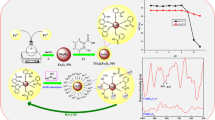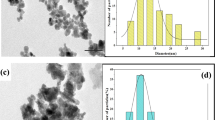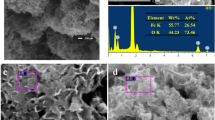Abstract
Magnetic Fe nanoparticles have the potential to treat As(V)-contaminated water. However, the effects of coexisting anions on the As(V) adsorption mechanism need further investigation. The batch adsorption experimental results obtained at pH 5 and room temperature were well represented by the mixed-order kinetic, and the sips isotherm models, indicating that surface adsorption dominated As(V) removal via chemical process onto a heterogeneous surface. The surface adsorption rate of As(V) was reduced in the single-anion systems, and this resulted in a decrease in the maximum sorption density (qm) of magnetic Fe nanoparticles for As(V) (74.9 mg/g) in the following order: H2PO4− (31.3 mg/g) > H4SiO4 (47.0 mg/g) > HCO3− (50.9 mg/g) > SO42− (54.9 mg/g) > Cl− (65.5 mg/g). The presence of Ca2+ in the multiple-anion system reduced the interference of coexisting anions (qm = 60.2 mg/g), possibly due to the formation of multiple Fe–As–Ca–As complexes. The results obtained from the electrophoretic mobility, FT-IR, and XPS indicated that the effects of coexisting anions on the adsorption mechanism of As(V) were driven by competitive surface complexation and redox reaction. The redox transformation of As(V) to As(III) was large in the single-anion system containing HCO3− (44.8%), SO42− (44.1%), and H4SiO4 (41.5%) because competing anions may form stable complexes with ≡Fe3+ site of magnetite, thereby enhancing the reduction of As(V) to As(III) on ≡Fe2+ site of magnetite. These findings expand the insight of As(V) uptake by magnetic Fe nanoparticles and help in predicting its performance in actual wastewater.








Similar content being viewed by others
Data Availability
The datasets supporting the conclusions of this article are included within the article and in the additional files submitted.
References
Bangari, R. S., Singh, A. K., Namsani, S., Singh, J. K., & Sinha, N. (2019). Magnetite-coated boron nitride nanosheets for the removal of arsenic(V) from water. ACS Applied Materials and Interfaces, 11, 19017–19028.
Chang, C. R., & Shyu, J. (1991). Coercivity of porous acicular particles. Journal of Applied Physics, 70, 7504–7509.
Christl, I., Brechbühl, Y., Graf, M., & Kretzschmar, R. (2012). Polymerization of silicate on hematite surfaces and its influence on arsenic sorption. Environmental Science and Technology, 46, 13235–13243.
De Oliveira, H., Campos, A., Gomide, G., Zhang, Y., & Ghoshal, S. (2020). Elaboration of a core@shell bimagnetic nanoadsorbent (CoFe2O4@γ-Fe2O3) for the removal of As(V) from water. Colloids and Surfaces a: Physicochemical and Engineering Aspects, 600, 125002.
Ge, J., Guha, B., Lippincott, L., Cach, S., Wei, J., Su, T. L., & Meng, X. (2020). Challenges of arsenic removal from municipal wastewater by coagulation with ferric chloride and alum. Science of the Total Environment, 725, 138351.
Ghosh, A., Kanrar, S., Nandi, D., Sasikumar, P., Biswas, K., & Ghosh, U. C. (2020). Redox-assisted arsenic(III) adsorption for removal from aqueous solution by cerium(IV)-incorporated zirconium oxide nanocomposites. Journal of Chemical and Engineering Data, 65, 895.
Goldberg, S., & Johnston, C. T. (2001). Mechanisms of arsenic adsorption on amorphous oxides evaluated using macroscopic measurements, vibrational spectroscopy, and surface complexation modeling. Journal of Colloid and Interface Science, 234, 204–216.
Gu, C., Wang, Z., Kubicki, J. D., Wang, X., & Zhu, M. (2016). X-ray absorption spectroscopic quantification and speciation modeling of sulfate adsorption on ferrihydrite surfaces. Environmental Science and Technology, 50, 8067–8076.
Guo, X., & Wang, J. (2019). A general kinetic model for adsorption: Theoretical analysis and modeling. Journal of Molecular Liquids, 288, 111100.
Hu, L., Ren, X., Yang, M., & Guo, W. (2021). Facet-controlled activation of persulfate by magnetite nanoparticles for the degradation of tetracycline. Separation and Purification Technology, 258, 118014.
Jadhav, S. V., Bringas, E., Yadav, G. D., Rathod, V. K., Ortiz, I., & Marathe, K. V. (2015). Arsenic and fluoride contaminated groundwaters: A review of current technologies for contaminants removal. Journal of Environmental Management, 162, 306–325.
Jiang, X., Peng, C., Fu, D., Chen, Z., Shen, L., Li, Q., Ouyang, T., & Wang, Y. (2015). Removal of arsenate by ferrihydrite via surface complexation and surface precipitation. Applied Surface Science, 353, 1087–1094.
Johnston, R. B., & Singer, P. C. (2007). Redox reactions in the Fe-As-O2 system. Chemosphere, 69, 517–525.
Kong, Y., Kang, J., Shen, J., Chen, Z., & Fan, L. (2017). Influence of humic acid on the removal of arsenate and arsenic by ferric chloride: Effects of pH, As/Fe ratio, initial As concentration, and co-existing solutes. Environmental Science and Pollution Research, 24, 2381–2393.
Lesiak, B., Rangam, N., Jiricek, P., Gordeev, I., Tóth, J., & Kövér, L. (2019). Surface study of Fe3O4 nanoparticles functionalized with biocompatible adsorbed molecules. Frontiers in Chemistry, 7, 642.
Liang, X., Lin, X., Wei, G., Ma, L., He, H., Santos-Carballal, D., Zhu, J., Zhu, R., & De Leeuw, N. H. (2021). Competitive adsorption geometries for the arsenate As(V) and phosphate P(V) oxyanions on magnetite surfaces: Experiments and theory. American Mineralogist, 106, 374–388.
Lin, S., Jin, J., Sun, S., & Yu, J. (2020). Removal of arsenic contaminants using a novel porous nanoadsorbent with superior magnetic recovery. Chemical Engineering Science: X, 8, 100069.
Meng, X., Bang, S., & Korfiatis, G. P. (2000). Effects of silicate, sulfate, and carbonate on arsenic removal by ferric chloride. Water Research, 34, 1255–1261.
METI Japanese Ministry of Economy Trade and Industry. (2006). Kougai Boushi no Gijutsu to Houki, Suishitu (in Japanese) (pp. 593–926). Maruzen.
Mi, T., Cai, Y., Wang, Q., Habibul, N., Ma, X., Su, Z., & Wu, W. (2020). Synthesis of Fe3O4 nanocomposites for efficient separation of ultra-small oil droplets from hexadecane-water emulsions. RSC Advances, 10, 10309–10314.
Morimoto, K., Anraku, S., Hoshino, J., Yoneda, T., & Sato, T. (2012). Surface complexation reactions of inorganic anions on hydrotalcite-like compounds. Journal of Colloid and Interface Science, 384, 99–104.
Nagarajan, D., & Venkatanarasimhan, S. (2019). Magnetite microparticles decorated cellulose sponge as an efficacious filter for improved arsenic(V) removal. Journal of Environmental Chemical Engineering, 7, 103386.
Nazari, A. M., Radzinski, R., & Ghahreman, A. (2017). Review of arsenic metallurgy: Treatment of arsenical minerals and the immobilization of arsenic. Hydrometallurgy, 174, 258–281.
Peng, B., Song, T., Wang, T., Chai, L., Yang, W., Li, X., Li, C., & Wang, H. (2016). Facile synthesis of Fe3O4@Cu(OH)2 composites and their arsenic adsorption application. Chemical Engineering Journal, 299, 15–22.
Pessoa Lopes, M., Galinha, C. F., Crespo, J. G., & Velizarov, S. (2020). Optimisation of arsenate removal from water by an integrated ion-exchange membrane process coupled with Fe co-precipitation. Separation and Purification Technology, 246, 116894.
Pincus, L. N., Rudel, H. E., Petrović, P. V. P., Gupta, S., Westerhoff, P., Muhich, C. L., & Zimmerman, J. B. (2020). Exploring the mechanisms of selectivity for environmentally significant oxo-anion removal during water treatment: A review of common competing oxo-anions and tools for quantifying selective adsorption. Environmental Science and Technology, 54, 9769–9790.
Poulin, S., França, R., Moreau-Bélanger, L., & Sacher, E. (2010). Confirmation of X-ray photoelectron spectroscopy peak attributions of nanoparticulate iron oxides, using symmetric peak component line shapes. Journal of Physical Chemistry C, 114, 10711–10718.
Rashid, M., Sterbinsky, G. E., Pinilla, M. Á. G., Cai, Y., & O’Shea, K. E. (2018). Kinetic and mechanistic evaluation of inorganic arsenic species adsorption onto humic acid grafted magnetite nanoparticles. Journal of Physical Chemistry C, 122, 13540–13547.
Samaei, S. M., Gato-Trinidad, S., & Altaee, A. (2020). Performance evaluation of reverse osmosis process in the post-treatment of mining wastewaters: Case study of Costerfield mining operations, Victoria Australia. Journal of Water Process Engineering, 34, 101116.
Schmidt, M. P., Siciliano, S. D., & Peak, D. (2020). Spectroscopic quantification of inner-and outer-sphere oxyanion complexation kinetics: Ionic strength and background cation effect on sulfate adsorption to hematite. ACS Earth and Space Chemistry, 2020, 1765–1776.
Shahid, M. K., & Choi, Y. (2020). Characterization and application of magnetite particles, synthesized by reverse coprecipitation method in open air from mill scale. Journal of Magnetism and Magnetic Materials, 495, 165823.
Shaikh, W. A., Alam, M. A., Alam, M. O., Chakraborty, S., Owens, G., Bhattacharya, T., & Mondal, N. K. (2020). Enhanced aqueous phase arsenic removal by a biochar based iron nanocomposite. Environmental Technology and Innovation, 19, 100936.
Shehzad, K., Xie, C., He, J., Cai, X., Xu, W., & Liu, J. (2018). Facile synthesis of novel calcined magnetic orange peel composites for efficient removal of arsenite through simultaneous oxidation and adsorption. Journal of Colloid and Interface Science, 511, 155–164.
Siddique, T. A., Dutta, N. K., & Choudhury, N. R. (2020). Nanofiltration for arsenic removal: Challenges, recent developments, and perspectives. Nanomaterials, 10, 1–37.
Song, Q., Huang, S., Xu, L., Wang, N., Hu, Z., Luo, X., & Zheng, Z. (2020a). Synthesis of magnetite/lanthanum hydroxide composite and magnetite/aluminum hydroxide composite for removal of phosphate. Science of the Total Environment, 723, 137838.
Song, Y., Yuan, P., Du, P., Deng, L., Wei, Y., & Liu, D. (2020b). A novel halloysite–CeOx nanohybrid for efficient arsenic removal. Applied Clay Science, 186, 105450.
Sun, Y., Chen, S. S., Tsang, D. C. W., Graham, N. J. D., Ok, Y. S., Feng, Y., & Li, X. D. (2017). Zero-valent iron for the abatement of arsenate and selenate from flowback water of hydraulic fracturing. Chemosphere, 167, 163–170.
Tanboonchuy, V., Grisdanurak, N., & Liao, C. H. (2012). Background species effect on aqueous arsenic removal by nano zero-valent iron using fractional factorial design. Journal of Hazardous Materials, 205–206, 40–46.
Tokoro, C., Yatsugi, Y., Koga, H., & Owada, S. (2010). Sorption mechanisms of arsenate during coprecipitation with ferrihydrite in aqueous solution. Environmental Science and Technology, 44, 638–643.
Tokoro, C., Kadokura, M., & Kato, T. (2020). Mechanism of arsenate coprecipitation at the solid/liquid interface of ferrihydrite: A perspective review. Advance Powder Technology, 31, 859–866.
USEPA (2001). Arsenic and Clarifications to Compliance and New Source Monitoring Rule.
Wan, J., Wu, B., & Lo, I. M. C. (2020). Development of Fe0/Fe3O4 composites with tunable properties facilitated by Fe2+ for phosphate removal from river water. Chemical Engineering Journal, 388, 124242.
Wang, J., & Guo, X. (2020). Adsorption kinetic models: Physical meanings, applications, and solving methods. Journal of Hazardous Materials, 390, 122156.
Weber, W. J., & Morris, J. C. (1963). Kinetics of adsorption on carbon from solution. Journal of the Sanitary Engineering Division, 89, 31–60.
World Health Organization (2017). Guidelines for drinking-water quality: First addendum to the Fourth Edition, Geneva; CC BY-NC-SA 3.0 IGO.
Wu, K., Jing, C., Zhang, J., Liu, T., Yang, S., & Wang, W. (2019). Magnetic Fe3O4@CuO nanocomposite assembled on graphene oxide sheets for the enhanced removal of arsenic(III/V) from water. Applied Surface Science, 466, 746–756.
Xu, X., Luo, J., Wei, S., Zou, X., Niu, X., & Pan, J. (2020). Three-dimensional flower-like multifunctional adsorbents with excellent sorptive removal and colorimetric detection of arsenate. Chemical Engineering Journal, 398, 125649.
Xue, Q., Ran, Y., Tan, Y., Peacock, C. L., & Du, H. (2019). Arsenite and arsenate binding to ferrihydrite organo-mineral coprecipitate: Implications for arsenic mobility and fate in natural environments. Chemosphere, 224, 103–111.
Yan, S., Zhou, K., Li, Y., He, Q., Xia, Ll., Liu, S., Li, H., Liang, D., & Song, S. (2020). Efficient removal of As(V) from diluted aqueous solutions by Fe/La oxide magnetic microspheres. Journal of Cleaner Production, 273, 123134.
Youngran, J., Fan, M., Van Leeuwen, J., & Belczyk, J. F. (2007). Effect of competing solutes on arsenic(V) adsorption using iron and aluminum oxides. Journal of Environmental Sciences, 19, 910–919.
Zhang, W., Zhang, G., Liu, C., Li, J., Zheng, T., Ma, J., et al. (2018). Enhanced removal of arsenite and arsenate by a multifunctional Fe-Ti-Mn composite oxide: Photooxidation, oxidation and adsorption. Water Research, 147, 264–275.
Zhang, Y., She, X., Gao, X., Shan, C., & Pan, B. (2019). Unexpected favorable role of Ca2+ in phosphate removal by using nanosized ferric oxides confined in porous polystyrene beads. Environmental Science & Technology, 53, 365–372.
Zhong, Y., Yu, L., Chen, Z. F., He, H., Ye, F., Cheng, G., & Zhang, Q. (2017). Microwave-assisted synthesis of Fe3O4 nanocrystals with predominantly exposed facets and their heterogeneous UVA/ Fenton catalytic activity. ACS Applied Materials and Interfaces, 9, 29203–29212.
Zubair, Y. O., Fuchida, S., & Tokoro, C. (2020). Insight into the mechanism of arsenic(III/V) uptake on mesoporous zerovalent iron-magnetite nanocomposites: Adsorption and microscopic studies. ACS Applied Materials and Interfaces, 12, 49755–49767.
Acknowledgements
This work was supported partially by the Ministry of Education, Culture, Sports, Science and Technology (MEXT), Japan. Part of this work was performed within the activities of the Research Project 20P07 of the Research Institute for Science and Engineering, Waseda University. This work was also supported by the Research Institute of the Sustainable Future Society and Research Organization for Open Innovation Strategy, Waseda University. We thank Kagami Memorial Research Institute for Materials Science and Technology, Waseda University, for the solid analysis. We thank Mauricio Córdova-Udaeta, Ph.D., from Waseda Research Institute for Science and Engineering for editing a draft of this manuscript. We thank Ian McNaught, PhD, from Edanz (https://jp.edanz.com/ac) for editing a draft of this manuscript.
Author information
Authors and Affiliations
Contributions
Yusuf O. Zubair: conceptualization, methodology, investigation, writing—original draft. Shigeshi Fuchida: conceptualization, writing—review and editing. Chiharu Tokoro: supervision, writing—review and editing.
Corresponding author
Ethics declarations
Competing Interests
The authors declare no competing interests.
Additional information
Publisher's Note
Springer Nature remains neutral with regard to jurisdictional claims in published maps and institutional affiliations.
Supplementary Information
Below is the link to the electronic supplementary material.
Rights and permissions
Springer Nature or its licensor (e.g. a society or other partner) holds exclusive rights to this article under a publishing agreement with the author(s) or other rightsholder(s); author self-archiving of the accepted manuscript version of this article is solely governed by the terms of such publishing agreement and applicable law.
About this article
Cite this article
Zubair, Y.O., Fuchida, S. & Tokoro, C. Adsorption and Microscopic Analysis of Arsenate Uptake by Magnetic Fe Nanoparticles: a Detailed Study on Coexisting Anions Effects. Water Air Soil Pollut 233, 484 (2022). https://doi.org/10.1007/s11270-022-05949-3
Received:
Accepted:
Published:
DOI: https://doi.org/10.1007/s11270-022-05949-3




